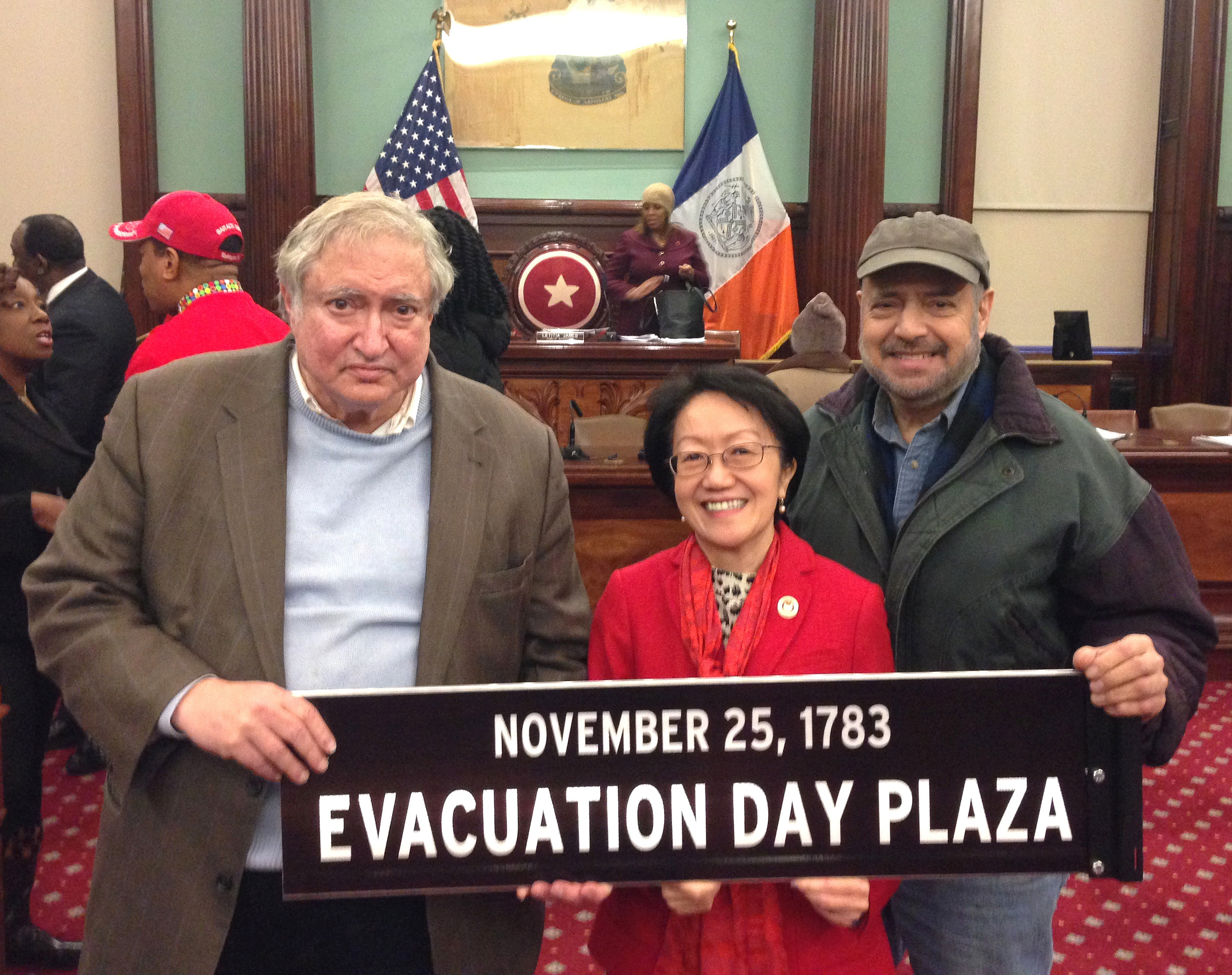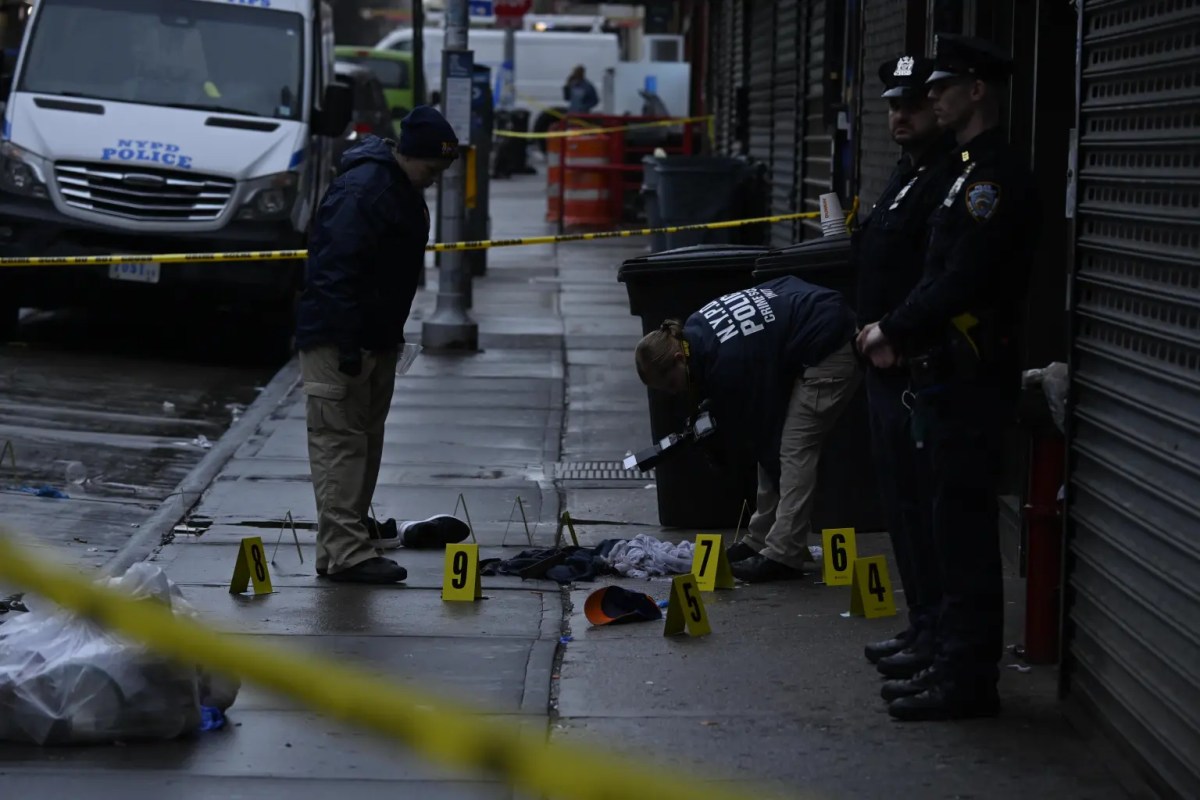
Downtown’s Councilmember Margaret Chin, center, beams in the Council chamber as she holds up the “Evacuation Day Plaza” sign just approved for Bowling Green, flanked by Lower Manhattan Historical Society co-founder James Kaplan on the left, and Bowling Green Association head Arthur Piccolo on the right.
BY BILL EGBERT |
Faced with outrage at its initial refusal to honor America’s victory in the Revolutionary War, the Council finally voted last week to co-name Downtown’s Bowling Green as “1783 Evacuation Day Plaza.”
Bowling Green was the site of that day’s most poignant moment, when a former prisoner of war named John Van Arsdale managed to climb the greased flagpole where the departing British had nailed a Union Jack, and replace it with the Stars and Stripes, just before Washington’s arrival.
“Celebrated by New Yorkers for more than a century, Evacuation Day symbolized the triumph of liberty, self-determination, and democracy over the forces of tyranny,” said Councilmember Margaret Chin, who sponsored the proposal to co-name the park. “It is my hope that with this official designation, Evacuation Day will again take its rightful place in the rich and colorful history of our City, which played such a vital role in the great American experiment that continues today.”
For one of the proposal’s main backers, the overcoming the Council’s initial resistance was Downtown’s own small triumph over another sort of tyranny.
“What we were truly battling was a disdain and ignorance about our history. There never should have been a battle to gain approval of Evacuation Day Plaza by the City Council. But then again, it never should have taken a revolution for Americans to win their freedom,” said Arthur Piccolo, head of the Bowling Green Association and co-founder of the Lower Manhattan Historical Society.
Councilmember Chin announced the co-naming proposal at last year’s Evacuation Day ceremony, even unveiling an “Evacuation Day Plaza” sign in anticipation of its swift approval, since the Council routinely supports co-namings endorsed by the local member.
So when the parks and recreation committee scheduled a vote last month to approve more than 40 street co-namings, supporters of the “Evacuation Day Plaza” proposal were stunned to discover that it had been struck from the list.
Council staff explained the rejection by pointing to the official guidelines for street co-namings, which limit the practice to honoring individuals or groups for outstanding civic service, rather than commemorating something as abstract as an event or holiday.
But the list of co-namings the parks committee was set to approve at its hearing last month included such abstractions as “Diversity Plaza” in Queens, “Ragamuffin Way” in Brooklyn, and “Hip Hop Boulevard” in the Bronx.
With outraged supporters of “Evacuation Day Plaza” rallying to storm the January hearing and demand justice, the parks committee canceled the vote entirely, delaying the full Council’s bi-annual consideration of street co-namings until this month.
“Thanks to the tireless work of our community, dedicated activists, and elected officials, Evacuation Day Plaza is now a reality. I would like to thank the Bowling Green Civic Association, the Lower Manhattan Historical Society, and Councilm
ember Chin for helping to make this co-naming possible,” said Community Board 1 chairwoman Catherine McVay Hughes.
Evacuation Day may struggle to get its due respect today, but for more than a century the holiday marking the end of the Revolutionary War was celebrated in America as fervently as the one that marked its start, the Fourth of July. After the Civil War, it was eclipsed by Thanksgiving, and official observations were mostly abandoned nearly a century ago when America allied with the British in World War I, but the Lower Manhattan Historical Society launched an effort to revive the holiday in 2014.
James Kaplan, co-founder and president of the society, hopes that honoring the holiday by co-naming Bowling Green will help rekindle interest in Downtown’s patriotic heritage.
“We think this is a great forward step in educating the people of Lower Manhattan and all New Yorkers about this very important holiday and the city’s Revolutionary War history,” he said.

















